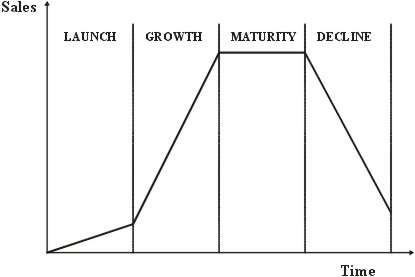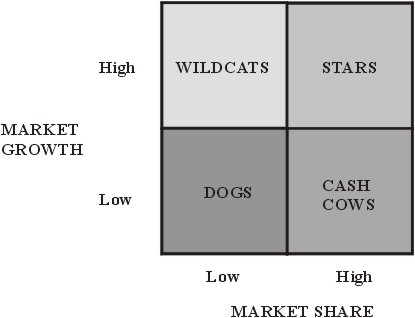|
Marketing & the Product Life-Cycle |
Product Life Cycle |
|
Most products and services are thought to pass through a number of phases that are rather like the birth, growth, maturation and eventual death of a living organism.
|
|
|
The main phases are launch/development, growth, maturity and decline.
|
|
|
The effect of these phases can be shown graphically.
|
|

|
|
|
Product life cycle
|
|
|
Clearly there can be no sales of a product until it is launched, so sales are zero until this time. Once the product has been launched sales will only grow slowly at first. This is because not all the potential clients of the product will know about it and people need time to evaluate the product at get used to it. However, after a certain point, if the launch is successful, sales will begin to pick up and there will be rapid growth. Yet every market is ultimately of finite size, so eventually the sales will reach a plateau. Finally, almost every product has substitutes, and some alternative will be produced that will appeal to customers more, and customers will switch to the new product; hence sales will decline.
|
|
|
Not every product will go through all these stages. Some companies seek to extend the life of their products by repackaging them and constant marketing — think of Coca Cola, for example. The maturity phase may be so long that the decline practically speaking never sets in. On the other hand, some new products do not make it past the launch phase.
|
|
|
So the product life cycle is not an economic or business law — it is simply a description of a cycle of events that happens to most, or at least many products.
|
|
Beating the product life cycle |
|
If a company produces a single product and that product follows the product life cycle, then it is inevitable that the company will eventually go into decline and be forced to close.
|
|
|
This may not be as bad as it sounds. If the company has made profits then the investors will have funds to move onto a different project or do something different with their lives. Also, during the decline phase the capital assets of the company will be sold, so there will be further cash for reinvestment as a result.
|
|
|
However, most companies would prefer not to go out of business. One way to avoid this is to extend the life of the product so that it never declines. This might be an objective of sustained marketing, as indicated already above.
|
|
|
Another way around the product life cycle is to create a range of products all at different stages of the product life cycle. When one product goes into decline another product will hopefully be reaching its maturity phase, and so on. This can only be achieved if the company invests in research and development.
|
|
|
When companies have a range of products all at different stages of the product life cycle, and possible serving different markets and different market segments, this is called a product mix.
|
|
The Boston matrix |
|
The Boston matrix is a device for classifying different products within a product mix, and may enable business managers to decide what further developments these products require.
|
|
 |
|
The Boston Matrix
|
|
|
The segments in the product mix correspond to different stages of the product life cycle. This starts with companies in the launch phase. These are the wildcat products (also called question mark products and problem child products). They are called wildcats because the outcome of marketing the product is uncertain.
|
|
|
The stars are the products that have made it past the problem child stage, and are now enjoying high growth as the “penetrate” the market. It makes sense to invest heavily in these products in order to accelerate the growth. The cash cows are those products in maturity. They have achieved their sales potential, and as such should be making substantial profits. Yet there is very little potential for market growth, so there is little point in investing further in them. The advice is to milk the profits for investment in other products — research and development, and the stars. Finally, there are the dogs, which have reached the end of the product life cycle and are now in decline. The advice is to simply get rid of these products.
|
|
|
Thus, marketing or corporate decisions arising from this analysis are
|
|
| 1 | | Get rid of a dog.
|
| 2 | | Milk a cash cow and reinvest elsewhere.
|
| 3 | | Invest in a star. |
| 4 | | Think hard about a problem child — is it a potential star or a potential dog? |
|
|
Product development |
|
The product life-cycle means that most firms can expect their products to decline in customer appeal; hence, a firm producing only one product can generally expect to go into voluntary liquidation after a certain period of time. Therefore, firms not wishing to wind up endeavour to develop new products (and to extend the life of those they already have). New product development is a risky and costly process. Generally, a development cycle is employed with a view to minimising the cost of failed products. This comprises:
|
|
| 1 | | Innovation: initial exploration of new ideas; |
| 2 | | Screening: a process of judging whether the new idea is worth passing on to later stages but an initial consideration of customer needs. |
| 3 | | Marketing analysis — full scale market research as described earlier. |
| 4 | | Product development including pilot production. |
| 5 | | Testing — that is, market experimentation using a test market. |
| 6 | | Full-scale production and launch. |
|
|
|
Clearly the cost of product development escalates as the firm proceeds further along the development cycle.
|
|
Value analysis
|
|
This is an analytical process to aid decision making in product development. The features of existing products are separately identified and customers are surveyed as to the value they place on each separate feature. In this way, a new product can be developed that incorporates and enhances those features that customers most value.
|
|